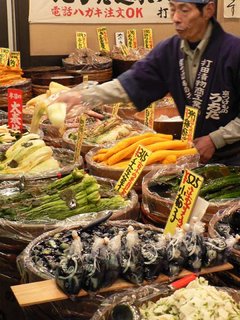 I dropped my pack at the hotel, but still had several hours before I would be allowed a bed to rest upon. So I wandered into the midst of downtown Kyoto and found myself on the main drag, surrounded by classy department stores. Impressive, but not what I had come to see. I struck off down a side street and came across a long undercover market selling every variety of Japanese food available. I was in heaven. Rice crackers, rice vinegar, rice wine, different grades of plain rice, rice pounded into mochi. Unidentifiable pickled vegetables, candies in minute design, barbequed skewered things, bread crumbed deep fried things. Some things packaged in layers upon layers, others opened for the prodding. There’s an essence of foreign food markets that tantalises the senses and emphasizes the differences between cultures more than
I dropped my pack at the hotel, but still had several hours before I would be allowed a bed to rest upon. So I wandered into the midst of downtown Kyoto and found myself on the main drag, surrounded by classy department stores. Impressive, but not what I had come to see. I struck off down a side street and came across a long undercover market selling every variety of Japanese food available. I was in heaven. Rice crackers, rice vinegar, rice wine, different grades of plain rice, rice pounded into mochi. Unidentifiable pickled vegetables, candies in minute design, barbequed skewered things, bread crumbed deep fried things. Some things packaged in layers upon layers, others opened for the prodding. There’s an essence of foreign food markets that tantalises the senses and emphasizes the differences between cultures more than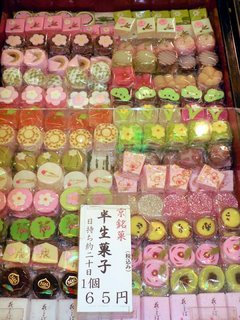 anything else. At such times I have mixed feelings about my vegetarianism. So many intriguing delicacies, so many that strike my stomach with fear and loathing! The camera came out and went click, click, click. A synthesized digital click to make the 35mm fan feel more comfortable. But the click is the same length whether the shutter speed is one sixtieth or one five hundredth. Somewhat disconcerting.
anything else. At such times I have mixed feelings about my vegetarianism. So many intriguing delicacies, so many that strike my stomach with fear and loathing! The camera came out and went click, click, click. A synthesized digital click to make the 35mm fan feel more comfortable. But the click is the same length whether the shutter speed is one sixtieth or one five hundredth. Somewhat disconcerting.I wound through back alleyways, through funky clothing districts, Gion, the theatre district, where I went chasing after Kabuki dancers in the touristy mission of another photograph.
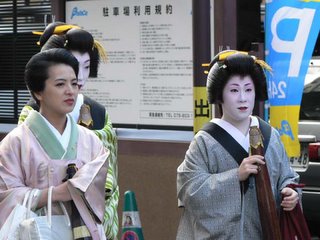 At first I thought they were Geisha, felt myself transported back into a more romantic era, the quintessence of the foreign conception of Japan. Geisha in Gion tripping down narrow alleyways in the impending evening to entertain wealthy, if not noble, men in teahouses scattered in quiet corners. But the surroundings were nothing like I’d imagined in the library of Japanese novels I’d been reading over the past fours years. But I was finally here and it was deliciously different and despite hoards of tourists, cars, modern buildings et al I was here - mind, body and spirit entwined.
At first I thought they were Geisha, felt myself transported back into a more romantic era, the quintessence of the foreign conception of Japan. Geisha in Gion tripping down narrow alleyways in the impending evening to entertain wealthy, if not noble, men in teahouses scattered in quiet corners. But the surroundings were nothing like I’d imagined in the library of Japanese novels I’d been reading over the past fours years. But I was finally here and it was deliciously different and despite hoards of tourists, cars, modern buildings et al I was here - mind, body and spirit entwined.I finally ended up outside Yasaka Shrine and Maruyama Park. Whilst looking for a toilet I found a noteworthy sign:
What to do in case of an earthquake.
Don’t rush outside.
Quickly put out fire.
Help neighbours.

The name Kobe came to mind, a city not so far away, forever connected to the idea of earthquakes in Japan, as Hiroshima and Nagasaki will always call forth more menacing connections. Over the next couple of days I would see these earthquake signs in localities all over Kyoto. I wondered why we didn’t have them on my little backwoods island of Shikoku. Were Japanese earthquakes too short ranged to reach the couple hundred kilometres away? Or does my country bumpkin island not rate as significant. The Marugame Earthquake. It doesn’t have quite the same ring. I hope. Thank goodness there’s only the Inland Sea between us and Kobe and not the Indian Ocean.
The steps leading up to the shrine were packed, as was the immediate complex. However a short walk towards the park and I found myself in a deserted temple complex and carried into my own personal nook of serenity. I breathed deep and long and moved on. I found a carp pond in the adjoining park and rested my weary legs on a sunny rock, hours of travel finally taking their toll.
Back at the hotel I was astonished and delighted to find the Book of Buddha in my bedside drawer, printed in both English and Japanese. I donned my yukatta and wriggled beneath a comfortingly heavy quilt.
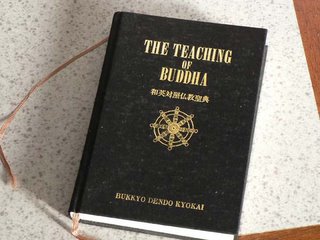
The next morning I awoke refreshed and happy! In Kyoto! A day of sightseeing ahead of me. I love these days where you wake up and know, for the whole day, you have only yourself to answer to. Yesterday I had my aimless wander; the joy of coming across unexpected adventures, today it was time for a more structured approach. A guidebook and several maps were in order, as was coffee and breakfast. In a cafe next to Kyoto Station, drinking bad coffee and munching on pancakes that had barely sniffed the advertised maple syrup, I decided two allocated destinations were necessary: a temple and a garden. Trying for anything more on a cold blustery day was foolishly begging for sore feet and over kill. Kyoto should be like dessert, where the exquisite aftertaste of a morsel is far preferable to feeling weary and bloated.
Kinkaku (Golden Pavilion) is the most famous temple in Kyoto. The day before I had seen hoards of tourists piling on buses bound there. Kinkaku was out. Leafing through assorted literature I found a temple that had a hall filled with 1001 female warriors, Sanjusangen Do. Destination number 1. Having seen enough sculpted trees to last a lifetime, a rock garden was my second priority, and thus destination number 2 would be Ryoanji Temple. As the temples were at either end of the city, I would also get to spend my day hopping on and off buses, hopefully getting lost in the meantime, a favourite pastime in strange cities.
Sanjusangen do was a long wooden hall. The name is derived from
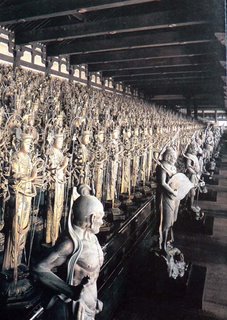 the architectural style and the thirty three spaces between the columns that support the building. There are 1001 statues of Kannon, the Buddhist goddess of mercy, each carved from cypress and coated with lacquer. In front of this army of goddesses are twenty eight other Hindu and Buddhist deities and in the middle is a huge Buddha. The original temple was burned down in 1249, but a faithful copy was reconstructed a short time after and has been standing ever since. No photos were allowed, which increased the atmosphere of reverence the temple had. A lone monk sat chanting in front of the central Buddha, and the air was filled with the smell of cedar wood and the continually burning candles and incense. Despite the unending procession of visitors the temple held a heavy aura of calm. As I regretfully left the building I felt as if time had slowed to half speed.
the architectural style and the thirty three spaces between the columns that support the building. There are 1001 statues of Kannon, the Buddhist goddess of mercy, each carved from cypress and coated with lacquer. In front of this army of goddesses are twenty eight other Hindu and Buddhist deities and in the middle is a huge Buddha. The original temple was burned down in 1249, but a faithful copy was reconstructed a short time after and has been standing ever since. No photos were allowed, which increased the atmosphere of reverence the temple had. A lone monk sat chanting in front of the central Buddha, and the air was filled with the smell of cedar wood and the continually burning candles and incense. Despite the unending procession of visitors the temple held a heavy aura of calm. As I regretfully left the building I felt as if time had slowed to half speed.I left Sanjusangen do and crossed the city on a
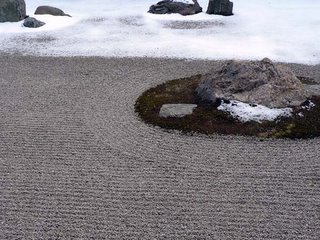 maze of buses. Luckily the bus drivers were pretty helpful and they also had guides at the main tourist interchange points. Walking up the drive towards Roanji do, the bushes sheltered patches of snow from the sunlight struggling valiantly down from above. The rock garden at Roanji do is probably the most famous Zen rock garden of its type. It comprises 15 rocks surrounded by a sea of gravel. I was looking forward to serenely contemplating this panorama for a long time and finding some zen of my own. Unfortunately they were currently renovating the garden wall, which left this
maze of buses. Luckily the bus drivers were pretty helpful and they also had guides at the main tourist interchange points. Walking up the drive towards Roanji do, the bushes sheltered patches of snow from the sunlight struggling valiantly down from above. The rock garden at Roanji do is probably the most famous Zen rock garden of its type. It comprises 15 rocks surrounded by a sea of gravel. I was looking forward to serenely contemplating this panorama for a long time and finding some zen of my own. Unfortunately they were currently renovating the garden wall, which left this  classic scene with a backdrop of tarps and scaffolding which somewhat killed the effect. The bustling, chattering crowd wedged onto a viewing platform at one side of the garden made any form of meditation impossible. I took a couple of interesting shots of the effect the line partially melted snow made across the gravel and headed off to explore the rest of the gardens. I found the beautiful Kyoyochi Pond, partially frozen over with mountainous rocks artfully protruding above the surface. Overhead, a late persimmon tree was showing off the last of its fruit.
classic scene with a backdrop of tarps and scaffolding which somewhat killed the effect. The bustling, chattering crowd wedged onto a viewing platform at one side of the garden made any form of meditation impossible. I took a couple of interesting shots of the effect the line partially melted snow made across the gravel and headed off to explore the rest of the gardens. I found the beautiful Kyoyochi Pond, partially frozen over with mountainous rocks artfully protruding above the surface. Overhead, a late persimmon tree was showing off the last of its fruit.It was still only early afternoon when I wandered out o
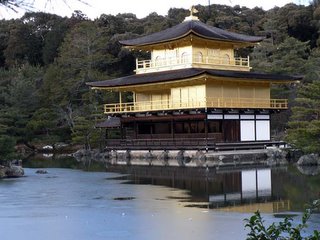 f Roanji do, and as I was in the immediate area I hopped on a bus up the road to Rokuon-ji do which houses the famed Kinkaku, or Golden Temple, so named because its walls are literally coated with a thick coat of gold. It has recently been restored and given a golden coat thicker than the original. On this crisp blue winter’s day the temple gleamed strikingly from its perch on the edge of the lake. The crowds jostling for position in the best vantage points couldn’t take away from the magnificence of this edifice and I was heartily glad I had come. I bought a postcard for my mum in the giftshop and found another score for myself; an English language cookbook on Japanese temple cooking, all of which, in true buddhist tradition, happens to be vegetarian. Tired and happy I scrambled onto a bus and spent the trip back to my hotel gazing over mouth watering dishes. My favourite so far is the tofu fried with almond.
f Roanji do, and as I was in the immediate area I hopped on a bus up the road to Rokuon-ji do which houses the famed Kinkaku, or Golden Temple, so named because its walls are literally coated with a thick coat of gold. It has recently been restored and given a golden coat thicker than the original. On this crisp blue winter’s day the temple gleamed strikingly from its perch on the edge of the lake. The crowds jostling for position in the best vantage points couldn’t take away from the magnificence of this edifice and I was heartily glad I had come. I bought a postcard for my mum in the giftshop and found another score for myself; an English language cookbook on Japanese temple cooking, all of which, in true buddhist tradition, happens to be vegetarian. Tired and happy I scrambled onto a bus and spent the trip back to my hotel gazing over mouth watering dishes. My favourite so far is the tofu fried with almond.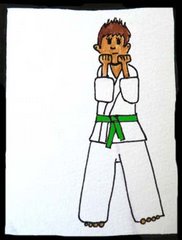

No comments:
Post a Comment